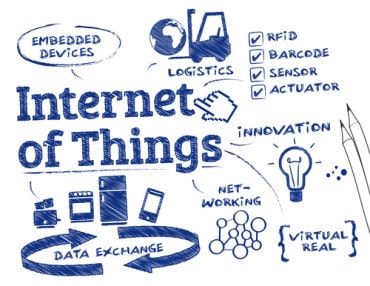
Mobile app development will accelerate, but businesses will have to address a talent gap. Also on the horizon: Wearables in the enterprise.
Today, there are more mobile devices in circulation than the global population. Not only that, but mobile internet use has surpassed that of desktops globally, and enterprises may feel the pressure to adapt traditional tasks to mobile. Fortunately, the shift to mobile is leading to positive returns and more agile business practices. Looking ahead through 2017 and beyond, a few clear trends are emerging in enterprise mobility.
Mobile becomes part of digital strategy
With the ever-growing presence of mobile devices in the workforce for both personal and business reasons, mobile should no longer be treated as a standalone initiative in the enterprise. In 2017, I predict mobile app development will become a key component of digital strategy. Enterprises are changing the way software is developed and deployed for mobile. DevOps tools and microservices enable more agile development methods, while API-based architectures in the cloud help deliver greater scalability and collaboration. (Related: “On microservices and event-driven architectures.“)
To support the transition to mobile, organizations should invest in tools that help them manage both the new generation of workloads and the more traditional applications they have been relying on.
As part of this transition, I expect to see more enterprises deploying container-based platforms to help streamline application development and reduce cost. The same tools that are enabling mobile to be successful in the enterprise are also playing an important role across other facets of digital strategy.
IT and business leader decision-making roles become more defined
These digital strategies can lead to transformation initiatives, and I believe the cooperation and collaboration among IT and business leaders is a key to their success; however, collaboration alone is not enough. Enterprises need more defined decision-making roles in the relationship between IT and line of business. With an anticipated increase in business leaders participating in mobile app development, enterprises need to be clear in what should be IT-led and what should be business-led.
In 2017, I see IT taking a leadership role in making key mobile development and implementation decisions, using microservices, APIs, platforms, and processes. IT has traditionally held budget and control for these areas. Business leaders, who often better understand the organizational needs, can lead decisions around mobile engagement channels, use cases, app features, design, and workflows. An organization’s success in mobile app development can hinge on whether IT and business leaders are able to effectively communicate their wants and needs, while maintaining these distinct roles.
The digital talent gap gets wider
Businesses are becoming software businesses, meaning that the competition for software talent can be intense. Skilled developers, in particular, come at a premium, driven partly by the need for companies to go digital and adapt their applications, infrastructure and processes accordingly. I predict the talent shortage will become even more pronounced as more companies advance their digital transformation efforts across core infrastructure, application modernization, cloud migration and management.
Hiring mobile app developers can be a highly competitive practice and access to a pool of talent is as much dependent on the developer skills as it is on the location, company culture, and perceived “coolness” of the technology. In 2017, I anticipate more companies will look for ways to use citizen developers and tools that can enable all employees, even the marketing executive or business analyst, to dabble in app development. Organizations should assess their existing talent pool and determine how well suited it is to the needs of today’s digital business, and then approach training accordingly. Prioritizing what development can be outsourced, what can be tackled by so-called citizen developers, and what projects need higher skilled in-house development teams should help enterprises address a talent gap.
Enterprise wearables become niche, tactical and customized in 2017
According to forecasts by industry analyst firm IDC, worldwide shipments of wearable devices are expected to top 97.3 million units by the end of 2016, representing 19.5 percent growth over the previous year. [1]
The enterprise wearable market lies within smart wearables, or those devices that are able to run third-party applications. I anticipate there will be growth in enterprise wearable use in 2017 as organizations seek to customize solutions across niche areas.
One factor that can contribute to the growth of wearables is having better-defined use cases within enterprise organizations. Job fields such as military and law enforcement, healthcare, manufacturing, and field services have already begun to benefit from wearable devices such as glasses, watches, and body cameras. (See: “How wearables and real-time data prevent fatigue-related accidents“).
From a technological standpoint, factors such as battery life, cellular capability and operating system maturity can go a long way toward improving the opportunity for wearable device success. Additionally, increased consumer adoption can lead to an uptick in bring-your-own-device approaches, similar to what helped spur smartphone adoption in the enterprise. Eventually, as enterprises move beyond the trial phase, I anticipate wearable adoption will become part of a holistic digital strategy.
I predict enterprise mobility will continue to mature in 2017, with organizations shifting to use mobile architectures for traditional business tasks. Additionally, with the ability to implement of more complex mobile projects and digital transformation initiatives, enterprises will increasingly define the roles of IT and business leaders in mobile development, as well as compete for digital talent, or invest in and train existing talent to meet the challenges of mobility. Finally, I predict enterprise wearable use will grow for niche job tasks and begin to move from the trial phase to becoming a part of overall mobile strategy. Companies that can successfully implement mobility stand to reap the benefits of a more agile and innovative business.
1. Source: IDC Worldwide Wearable Devices Tracker, 2016Q3,






























